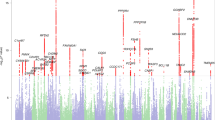Abstract
The probative analysis of genotype-phenotype relations in familial dyslexia requires operationally defined psychobiological outcome variables that are not confounded by cultural differences of orthography or other factors that may influence the clinical ascertainment and diagnosis of dyslexia. Timing precision, as expressed in coordinated motor action, was used as an objective behavioral measure that can be mapped on current knowledge of central nervous system functions as well as on the most salient nonreading deficits in developmental dyslexia. Dyslexia families with four distinct pedigrees and a normally reading reference group were the study subjects. The results indicated that impaired timing precision in bimanual coordination and in motor speech were transmitted vertically in affected members of about half of dyslexia families. Motor coordination deficits were associated with a disposition to make dysphonemic spelling errors. It is proposed that impaired timing precision identifies a behavioral phenotype in some familial dyslexia subtypes. The detailed analysis of coarticulation in speech production may be one pathway by which impaired timing precision in motor action impinges on reading and writing deficits in developmental dyslexia.
Similar content being viewed by others
References
Baron M, Endicott J, Ott J (1990) Genetic linkage in mental illness. Limitations and prospects. British Journal of Psychiatry 157:645–655
Denckla MB (1993) A neurologist’s overview of developmental dyslexia. Annals of the New York Academy of Science 682:23–26
Farmer ME, Klein RM (1995) The evidence for a temporal processing deficit linked to dyslexia: A review. Psychonomic Bulletin & Review 2: 460–493
Fodor J (1983) The Modality of Mind. MIT Press: Cambridge, MA
Folkins JW, Bleile KM (1990) Taxonomies in biology, phonetics, phonology, and speech motor control. Journal of Speech and Hearing Disorders 55:596–611
Fowler CA, Rubin P, Remez RE, Turvey MJ (1980) Implications for speech production of a general theory of action. In: Butterworth B (ed), Language Production (pp 373–420). New York: Academic Press
Goodwin BC (1994) How the Leopard Changed its Spots: The Evolution of Complexity. New York: Scribner’s Sons
Heilman KM, Voeller K, Alexander AW (1996) Developmental dyslexia: A motor articulatory-feedback hypothesis. Annals of Neurology 39: 407–412
Kaufman SA (1993) The Origins of Order. New York: Oxford University Press
Kelso JAS, Saltzman EL, Tuller B (1986) The dynamical perspective on speech production: Data and theory. Journal of Phonetics 14: 29–59
Kimura D, Archibald Y (1974) Motor function of the left hemisphere. Brain 97: 337–350
Lashley KS (1951) The problem of serial order in behavior. In: Jeffries LA (ed) Cerebral Mechanisms in Behavior (pp 112–136). New York: Wiley
Liberman A (1993) In speech perception, timing is now what it seems. Annals of the New York Academy of Sciences 682: 264–271
Llinas R (1993) Is dyslexia a dyschronia? Annals of the New York Academy of Sciences 682: 48–56
MacNeilage PF (1970) Motor control of serial ordering of speech. Psychological Reviews 77: 182–196
Mann VA (1986) Why some children encounter reading problems: The contribution of difficulties with language processing and phonological sophistication to early reading disability. In: Torgesen JK, Wong BYL (eds) Psychological and Educational perspectives on Learning Disabilities (pp 133–149). New York: Academic Press
Ojemann G (1984) Common cortical and thalamic mechanisms for language and motor function. American Journal of Physiology 246: R901-R903
Pennington BF (1991) Annotation: The genetics of dyslexia. Journal of Child Psychology and Psychiatry 31: 193–201
Rack JP, Snowling MJ, Olson RK (1992) The nonword reading deficit developmental dyslexia. Reading Research Quarterly 27: 28–53
Risch N (1990) Genetic linkage and complex diseases, with special reference to psychiatric disorders. Genetic Epidemiology 7: 3–16
Sperry RW (1952) Neurology and the mind/brain problem. American Scientist 40: 291–312
Stanovich KE, Siegel LS (1994) Phenotypic performance profile of children with reading disabilities: A regression-based test of the phonological-corer variable difference model. Educational Psychology 86: 24–53
Studdert-Kennedy M, Mody M (1995) Auditory temporal perception deficits in the reading-impaired: A critical review of the evidence. Psychonomic Bulletin and Review 2: 508–514
Wolff PH (1976) Theoretical issues in the development of motor skills. In: Lewis M, Taft L (eds) Developmental Disabilities, Theory, Assessment and Intervention. Jamaica, NY: SP Medical & Scientific Books
Wolff PH (1993) Impaired temporal resolution in developmental dyslexia. Annals of the New York Academy of Sciences 682: 87–103
Wolff PH, Melngailis I (1994) Family patterns of developmental dyslexia: Clinical findings. American Journal of Medical Genetics 54: 122–131
Wolff PH, Melngailis I, Obregon M, Bedrosian M (1995) Family patterns of developmental dyslexia, part II. American Journal of Medical Genetics 60: 494–505
Wolff PH, Melngailis I, Kotwica K (1996) Family patterns of developmental dyslexia, part III. American Journal of Medical Genetics 67: 378–386
Wolff PH, Michel GF, Ovrut M, Drake C (1990a) Rate and timing precision of motor coordination in developmental dyslexia. Developmental Psychology 26: 349–359
Wolff PH, Michel GF, Ovrut M (1990b) The timing of syllable repetitions in developmental dyslexia. Journal of Speech and Hearing Research 33: 281–289
Author information
Authors and Affiliations
Rights and permissions
About this article
Cite this article
Wolff, P.H. A candidate phenotype for familial dyslexia. European Child & Adolescent Psychiatry 8 (Suppl 3), S21–S27 (1999). https://doi.org/10.1007/s007870050123
Issue Date:
DOI: https://doi.org/10.1007/s007870050123




